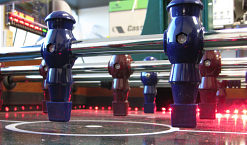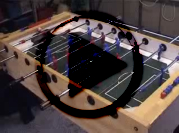
I, Foosball Player
By André Voshart
Motion Control Research Robotics UniversityUniversity of Waterloo students develop "medium skilled" robotic defensive and offensive table-soccer players.

Keep up to date with the latest Canadian robotic and design news by subscribing to our bi-monthly newsletter.
When robots began doing menial jobs for us, who would have guessed they’d start playing our games for us, too? It turns out a group fourth-year electrical and computer-engineering students at the University of Waterloo did.
In January 2008, as their final-year project, the eight-man team constructed a robot-controlled, motor-and-actuator foosball table capable of playing against human opponents in a two-on-two fashion; one mechanical player controls two defensive rods (goalies and full-backs) and the other controls two offensive rods (half-backs and forwards).
From there, they outlined two separate projects: Project Defence, which needed to implement detection, a brain and a control system for the two defensive rods. Project Offense was to implement an independent system for the offensive rods. Each team set off to design their projects independently, and the result was two fully functioning, collaborative computer players.
“Project Defense developed a system of lasers and photo detectors suspended just above the surface level of the table to detect the ball location using a grid,” explains Phillip Nadeau, who, along with Joseph De Filippis, Karmon Mah and Andy Zhang, was a member of the laser-grid team.
The second group, manned by Prateek Bhatnagar, Brandon Hayes, Mohammad Sharafat and Justin Groenestege, developed the offensive capabilities using a high-speed camera suspended above the table and an image-processing algorithm to detect the ball and rod positions in real time. The positions from both teams are then fed into their respective “brains,” a set of FPGA-based Altera DE-2 development boards. » Engineering details on next page











